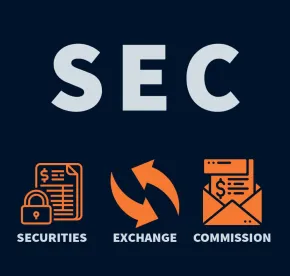On December 14, 2022, the SEC adopted amendments to Rule 10b5-1 under the Securities Exchange Act of 1934 and added related new disclosure requirements. Rule 10b5-1 provides an affirmative defense to insider trading liability for individuals and companies in circumstances where, subject to certain conditions, the trade was pursuant to a written plan adopted when the trader was not aware of material nonpublic information. As anticipated, the SEC has tightened up the availability of this defense by codifying many existing "voluntary" practices, imposing new procedural requirements, and requiring new disclosure obligations by issuers and Section 16 filers. The SEC will likely follow this rulemaking process with enforcement action.
In light of these new requirements, and likely enhanced public and regulatory scrutiny, public companies may become more restrictive in allowing the adoption and implementation of 10b5-1 plans by their directors, officers and other employees. Public companies should update their policies and procedures to account for the new requirements and the obligations to file their insider trading policies publicly as exhibits, and to consider the relative timing of grants of options and similar equity awards. Fund managers and other investors in public companies that utilize Rule 10b5-1 trading plans should also review their policies and existing plans in light of the new cooling off period requirements and restrictions on overlapping plans.
Key Dates
-
The amendments to Rule 10b5-1 will be effective 60 days after the adopting release is published in the Federal Register, with a likely effective date in late February or early March of 2023.
-
For non-smaller reporting companies, the disclosure requirements regarding insider trading policies, use of Rule 10b5-1 plans, and executive and director compensation arrangements will first be required for filings that cover the first full fiscal period that begins on or after April 1, 2023. For smaller reporting companies, the disclosure will be required for filings that cover the first full fiscal period that begins on or after October 1, 2023.
-
The amendments to Forms 4 and 5 will be effective for filings made on or after April 1, 2023.
The SEC’s adopting release is available here, and the fact sheet relating to the final rules is available here.
A. Amendments impacting Rule 10b5-1 Trading plans
In proposing amendments to Rule 10b5-1, the SEC expressed concern with what it perceived as potentially abusive practices engaged in by public companies, directors and officers relating to Rule 10b5-1 trading plans, certain equity awards and gifts of securities. The rule changes adopted by the SEC amend the Rule 10b5-1 affirmative defense to insider trading liability to include the following new conditions to the availability of the rule.
-
Mandatory cooling off periods
A “cooling off” period refers to the time between the adoption or amendment of a Rule 10b5-1 trading plan and when the first trade under the plan may occur.
For directors and officers,[1] under the revised rules, no trades can be made under a 10b5-1 plan until the later of (1) 90 days following adoption or modification of the plan, or (2) two business days following the disclosure in a periodic report of the issuer’s financial results for the fiscal quarter in which the plan was adopted or altered (but not to exceed 120 days following plan adoption or modification).
In practice, the cooling off period for officers and directors of U.S. domestic companies should generally be 90 days based on the new requirements, but plans adopted or modified in the fourth quarter may have longer cooling off periods that delay the commencement of trades until two business days after the filing of the Form 10-K, given the later filing deadlines for a Form 10-K. The financial results for a foreign private issuer will be disclosed in a Form 20-F or Form 6-K.
For investors other than officers or directors, the new rules will require a cooling off period of 30 days between the plan’s adoption and commencement of trading under the plan.
Amendments to 10b5-1 trading plans that would trigger a new cooling off period include changes to the amount, price or timing of purchases or sales, or a change to a formula or algorithm that affects the amount, price or timing of trades under the plan.
The SEC had proposed including a cooling off period for issuers as well but this was not included in the final rules. The SEC noted in the adopting release that it is “continuing to consider whether regulatory action is needed to mitigate any risk of investor harm from the misuse of Rule 10b5-1 plans by the issuer…”, so the SEC may undertake additional rulemaking impacting the use of Rule 10b5-1 plans by issuers in the future.
While Rule 10b5-1 has not previously required cooling off periods, many companies imposed cooling off periods of various lengths and these are a typical feature of many existing 10b5-1 plans.
-
Director and officer certifications
Under the new rules, directors and officers must include a representation in their Rule 10b5-1 plan certifying, at the time of the adoption of a new or modified plan, that they (1) are not aware of material nonpublic information about the issuer or its securities, and (2) are adopting the plan in good faith and not as part of a plan or scheme to evade the prohibitions of Rule 10b-5.
While these requirements are not included in the current version of Rule 10b5-1, in practice these types of representations are generally required by most broker-dealers when a customer adopts a 10b5-1 plan to be implemented by the broker.
-
Restrictions on overlapping plans
Revised Rule 10b5-1 prohibits persons, other than the issuer, from having more than one 10b5-1 plan or other arrangement in effect that would qualify for the affirmative defense under Rule 10b5-1 for transactions effected during the same period.
This prohibition is subject to the following exceptions:
-
Separate 10b5-1 plans with different broker-dealers or other agents to execute trades of securities held in separate accounts will still be permitted, so long as the contracts or arrangements, when taken as a whole, meet all of the applicable conditions of the rule.
-
A later-commencing plan will be permitted if trading under the later-commencing plan is not authorized to begin until after all trades under the earlier-commencing plan are completed or expire without execution.
-
Plans for sell-to-cover transactions that only authorize sales necessary to satisfy tax withholding obligations arising exclusively from the vesting of compensatory awards will still be permitted.
When relying on these exceptions, particular care needs to be taken to ensure the cooling off periods are still met. For purposes of the cooling off period for a later-commencing plan, the date of adoption of the later-commencing plan is deemed to be the date of termination of the earlier-commencing plan.
-
Restricting single-trade arrangements
The revised rule will also prohibit persons other than the issuer from relying on the defense for multiple single-trade plans in any 12-month period. A single-trade plan is a plan that is designed to effect the open market purchase or sale of the total amount of securities under the plan as a single transaction. Under the new rules, only one of these types of plan may be relied upon in any 12-month period.
-
Amended good faith condition
Finally, the new rule will include a revised good faith condition that will require all persons entering into a 10b5-1 plan (including the issuer) to act in good faith with respect to that plan throughout the duration of the plan. Current Rule 10b5-1 requires that a person act in good faith in connection with entering the plan.
B. Additional Disclosure Requirements
In connection with revising Rule 10b5-1, the SEC also adopted new Item 408 and Item 402(x) of Regulation S-K that add additional disclosure obligations for companies regarding their insider trading policies and practices and the use of 10b5-1 plans by their officers and directors.
New Item 408 will require quarterly disclosure by public companies regarding the adoption, termination and material terms of Rule 10b5-1 trading plans or other preplanned trading arrangements entered into, amended or terminated by the issuer’s officers and directors (but not by the issuer) during the quarter. The required disclosure will include:
-
The name and title of the officer or director;
-
The date of adoption or termination;
-
The duration of the trading arrangement; and
-
The aggregate number of securities traded under the trading arrangement.
The price at which the individual executing the 10b5-1 plan or arrangement is authorized to trade will not need to be disclosed.
Additionally, Item 408 (and new Item 16J of Form 20-F for foreign private issuers) will require companies to disclose on an annual basis whether they have adopted insider trading policies and procedures governing the purchase, sale and disposition of the company’s securities. If a company has not adopted such policies, it must explain why they have not done so. Companies will also file copies of their insider trading policies and procedures as an exhibit to their Form 10-K (or Form 20-F for a foreign private issuer). While most companies already have insider trading policies, they will now need to file them publicly with their SEC filings.
New Item 402(x) of Regulation S-K will require companies to provide narrative disclosure regarding their policies and practices on timing of awards of stock options and other similar option-like instruments in relation to their disclosure of material nonpublic information. This new rule codifies prior SEC guidance that encouraged companies to disclose in their CD&A any plan or practice of timing option grants in coordination with the release of material nonpublic information. The new disclosure obligation will also require companies to provide tabular disclosure of awards made in the four business days before a periodic or current report filing that discloses material nonpublic information and ending one business day after the filing or furnishing of such report. These disclosures will be required in annual reports on Form 10-K and proxy statements on Schedule 14A.
C. Section 16 Reporting
The SEC has also amended Forms 4 and 5 filed under Section 16 of the Exchange Act to include a new checkbox to indicate whether a reported transaction is pursuant to a plan that is intended to satisfy the conditions of Rule 10b5-1.
In addition, Rule 16a-3 has been amended to require reports of gifts of securities on Form 4 within two business days. Previously, filers could voluntarily report a gift on a Form 4, or on a Form 5 due within 45 days of the issuer’s fiscal year end.
FOOTNOTES
[1] For purposes of the revised rule, “officer” will have the meaning provided in Rule 16a-1(f) under the Exchange Act.




 />i
/>i

